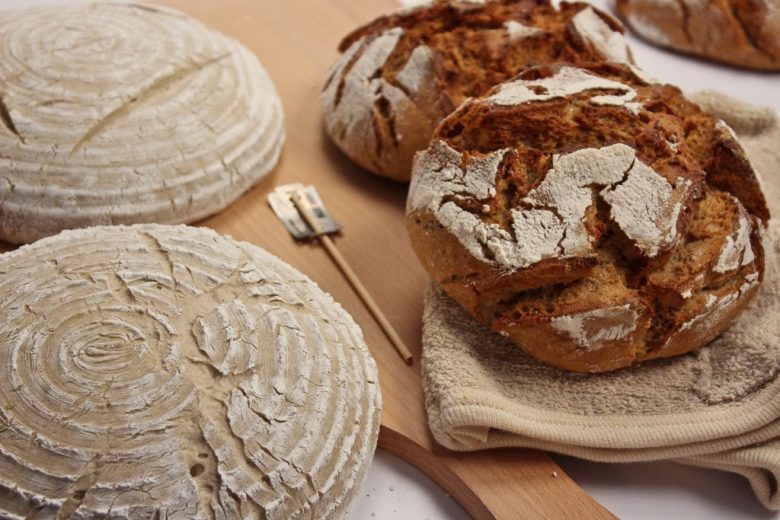Baking Your Bread Dough
The task of baking is to transform the dough into wholesome, tasty bread and baked goods. At the end of baking, the following criteria should be met, depending on the type of bread:
- Crust should be tender, crisp and crusty
- Crust color golden yellow to deep dark brown
- Crumb stretchy and elastic
- Full to open pores
- Volume compact to voluminous
Preparing the bread for the baking process has a major impact on the end product. The bread is placed on a baking peel, scores, dimpled, sprinkled, coated, dusted and reshaped. The proof, the dough structure, the dough surface and the baking atmosphere are also decisive.
- The baking temperatures are divided into four temperature ranges:
- 260-240 ° C hot
- 240-220 ° C warm
- 220-205 ° C medium warm
- 205-185 ° C mild
The determination of the baking temperature and the baking time depends on the recipe, the hydration, the size of the dough and the shape. There is no exact temperature in my blog because the temperature varies depending on the type of oven.
Unfortunately, in many household ovens, the specified temperatures are not correct. Deviations of up to thirty degrees are quite common. I therefore recommend buying a heat-resistant thermometer and mounting it in the oven. This allows you to constantly monitor the temperature.
Scoring the Dough:
Many types of bread are scored on the top before baking. The purpose of this is that the excess pressure that develops in the dough is diverted in a targeted manner during baking. You could also say that the scoring takes on the function of a pressure relief valve.
Wheat dough is scored once 3/4 proofed and baked immediately afterwards. Fully proofed loaves of bread result in an unattractive formation after scoring, because the increase in volume during baking is less. Only sharp knives should be used to score the bread, but razor blades are also very popular in practice.
Steam:
Most breads require a sufficiently moist baking atmosphere for optimal oven spring. The amount of steam fed into the baking chamber immediately moves to the coolest place, the surface of the dough. When it cools down, condensation forms, which means that the surface of the dough remains flexible and can give way to the pressure of the fermentation gases. The excess steam should be let out after the bread has risen to ensure a well-baked, crispy crust.
Advantages of steaming:
- Better shine of the bread
- Nicer appearance
- The volume increases
- The bread crust won’t dry out because the fermentation gases develop the bread
Baking time:
Average baking time for free standing rye, mixed rye, and mixed wheat breads:
- 1000g Mixed wheat breads BT: 45-50 minutes
- 1000g Rye and mixed rye breads BT: 60 minutes
- 2000g Rye and mixed rye breads BT: 75 minutes
- 3000g Rye and mixed rye breads BT: 90 minutes
In comparison to wheat breads, rye and mixed rye breads are baked at a higher (hotter) initial temperature (250-270°C) and fully baked at a slightly lower temperature (200°C).
Bread Character:
The characteristic appearance of some types of bread results from the interplay of several or individual factors:
- Level of proofing
- Oven temperature
- Steam amount
- Timeline of releasing the steam (draft control)
Crumb Development
In contrast to the surface of the dough, the heat from the oven penetrates the inside of the dough more slowly. The temperature there reaches at most the boiling point of water. Often this is not even achieved even though the bread is completely baked. The gelatinization temperature of wheat starch and rye starch is not identical.
- Wheat starch gelatinizes at a crumb temperature of 65-90°C
- Rye starch gelatinizes at a crumb temperature of 55-70°C
What does the gelatinization of starch even mean?
When the temperature increases (55-90°C) the starch changes in the following ways:
- Starch swells
- Starch shell bursts
- Contents escape = the starch is gelatinized
Crust Development
The crust begins to form even before the oven spring. As the outer layer of dough dries out, a tender to crispy crust is created, depending on the recipe.
- 100°C water evaporation
- 120°C formation of light-colored dextrins
- 140°C formation of dark dextrins
- 150°C formation of aromatic compounds
- 160°C continuation of dextrin formation
- 200°C charring, formation of bitter compounds
In a normally heated oven, the crust temperature is 150-180°C. Because the heat is not transmitted everywhere at the same time, the coloring is strongest on the bottom and on the top.
Process of Baking Bread:
- 35-50°C Intensive rising, increasing enzyme activity
- 50°C Death of the sour bacteria, inhibition of yeast fermentation
- 55°C Begin of the starch gelatinization
- 50-65°C Stronger enzyme activity
- 60°C End of the yeast rise, the proteins coagulate
- 70°C Evaporation of alcohols
- 80°C End of enzyme activity, kill off of mold bacterias
- 100°C Strong water vapor pressure
- 100-140°C Dextrin development
- 140-150°C Caramelization
- 200°C Crust develops
When is a bread finished baking ?
The needle test: You prick the -probably- well-baked bread with a knitting needle. If no dough remains stuck to the needle, the bread is baked through.
The knock test: Tap the bottom of the – presumably – finished bread. If it sounds hollow, the baking process is over.


